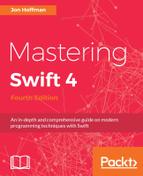You may have noticed that in the object-oriented design we used classes, while in protocol-oriented design we used structures. Classes, which are reference types, are one of the pillars of object-oriented programming and every major object-oriented programming language uses them. For Swift, Apple has said that we should prefer value types (structures) to reference types (classes). While this may seem odd for anyone who has extensive experience with object-oriented programming, there are several good reasons for this recommendation.
The biggest reason, in my opinion, for using structures (value types) over classes is the performance gain we get. Value types do not incur the additional overhead for reference counting that reference types incur. Value types are also stored on the stack, which provides better performance as compared to reference types, which are stored on the heap. It is also worth noting that copying values is relatively cheap in Swift.
Keep in mind that, as our value types get large, the performance cost of copying can negate the other performance gains of value types. In the Swift standard library, Apple has implemented copy-on-write behavior to reduce the overhead of copying large value types.
With copy-on-write behavior, we do not create a new copy of our value type when we assign it to a new variable. The copy is postponed until one of the instances changes the value. This means that, if we have an array of one million numbers, when we pass this array to another array we will not make a copy of the one million numbers until one of the arrays changes. This can greatly reduce the overhead incurred from copying instances of our value types.
Value types are also a lot safer than reference types, because we do not have multiple references pointing to the same instance, as we do with reference types. This really becomes apparent when we are dealing with a multithreaded environment. Value types are also safer because we do not have memory leaks caused by common programming errors, such as the strong reference cycles discussed in Chapter 5, Classes and Structures.
Don't worry if you do not understand some of the items discussed in this section. The thing to understand is that value types, like structures, are safer, and for the most part provide better performance in Swift, as compared to reference types, such as classes.
Now that we have a better understanding of protocol-oriented design, let's once again look at the array structure provided in the Swift standard library.
